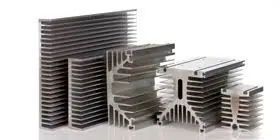Heat sinks are crucial components of any device. From computers to smartphones, video game consoles and other electronics, heat sinks provide a means for absorbing and releasing the heat generated by these devices to keep their temperatures within acceptable limits.
Heat sinks may either be active or passive. These are the 2 categories that are often used to describe them. Active heat sinks refers to heat sinks that have moving parts such as blowers and fans to dissipate thermal energy within the enclose. Passive heat sinks on the other hand have no mechanical parts within them. They simply do away with all the thermal energy using a convection process.
Heatsinks may be manufactured using a number of process with aluminum or copper as the primary material. At times, both materials may be used. Here’s how aluminum extrusion is used in making these heat sinks and how to select the best option for your project.
Extruded Aluminum Heat Sinks
Aluminum is one of the most common materials for making heat sinks globally. This is because this metal is light weight and has a fair thermal conductivity. Extruded Aluminum heat sinks are low cost and can be made to specifications, however, copper heat sinks may boast of higher thermal conductivity and weight. FirstPart offers high quality aluminum extrusion services that can help tailor and optimize the performance of your aluminum heat sinks.
CNC Machined Heat Sinks
Computer numerical control (CNC) machines can be used to produce aluminum heat sinks for an array of applications. The benefit of employing CNC machines for aluminum heat sinks is the complex geometries that can achieved. CNC machining allows developers to break the bounds of conventional design and explore flexibilities in designing the heat sink.
The downside to CNC machined aluminum heat sinks is the cost of production and production leas time. If CNC is to be used, production volumes must be for mass production levels.
Stamped Heat Sinks
Through sheet metal operations, aluminum heat sinks can be created by stamping and soldering. Stamped heat sinks are generally used where high-power is not involved. The benefits range from their low cost to ease and speed of aluminum molds for injection molding, while the downsides is their inability to deal with high-performing set-ups.
Composite heat sinks
Composite heat sinks are heat sinks consisting of more than one material. They are usually used for large processes that require bigger heat sinks. And since the materials may be different, composite heat sinks can leverage the material properties of both composites to deliver an overall more efficient heat sink. An aluminum-copper heat sink will deliver improved thermal performance with minimal amount of additional weight. The performance for composites heat sinks are usually above average but they are also relatively more expensive.
First Part Aluminum Extrusion and CNC Machining
At First Part, our aluminum extrusion and CNC machining processes can deliver the best heat sinks that will absorb and disperse the heat generated by your electronics. The volume of the compartment, the design and intended weight/size of the heat sink are some of the more important considerations. First Part also delivers both active and passive heat sinks from both copper and aluminum. If CNC machining, sheet metal stamping or Aluminum extrusion is one of the services you’re looking for, click here to contact us to get a free quote and design inspection to get started on your project.










